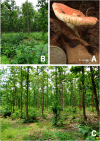Introducing a novel mushroom from mycophagy community with emphasis on biomedical potency
- PMID: 28552988
- PMCID: PMC5446119
- DOI: 10.1371/journal.pone.0178050
Introducing a novel mushroom from mycophagy community with emphasis on biomedical potency
Abstract
Mushrooms have been prized by humankind as medicine and culinary wonder since antiquity. Though several species are ethnically valued; many prospective species are still being discovered. One such wild macrofungus has recently been discovered during subsequent field surveys in West Bengal, India which in turn exposed as a traditionally consumed popular myco-food. The collected taxon was found to be unique with regard to its morphological as well as genetical features. After detailed characterizations, the fungus was identified as a novel taxon belonging to the genus Russula (Russulaceae, Basidiomycota). Besides, the investigation was further extended in search of new functional ingredients and in this context, a water soluble crude polysaccharide rich extract (Rusalan) was isolated from dried basidiocarps. Accumulating evidences from GC-MS, HPTLC, FT-IR along with several spectrophotometric methods postulated that the fraction consisted mainly of carbohydrate in triple helical conformation, where glucose was the major monosaccharide mostly with β-type glycosidic linkage. Conversely, Rusalan showed pronounced antioxidant activity in six in vitro assay systems with EC50 value ranging from 190-1328 μg/ml concentration. The crude polysaccharide was also evaluated against six bacterial strains using microdilution method and the growth of Staphylococcus aureus and Bacillus subtilis were found to be inhibited effectively. In addition, immune-stimulatory assays demonstrated that Rusalan could evidently promote proliferation, induce phagocytosis, release NO, produce intracellular ROS and upregulate mRNA expression of iNOS, TNF-α, COX-2, as well as IL-6 genes in in mouse macrophage cells. Therefore, aim of the present study was not only to describe a new taxon to the world mycoflora but also to introduce a potent therapeutic agent that could be explored for food and pharmaceutical purposes. However, isolation of active component and in vivo studies need to be designed further.
Conflict of interest statement
Figures









References
-
- Hsieh P, Wu J, Wu Y. Chemistry and biology of Phellinus linteus. Biomed. 2013; 3: 106–113.
-
- Akramienė D, Kondrotas A, Didžiapetrienė J, Kėvelaitis E. Effects of β-glucans on the immune system. Medicina (Kaunas). 2007; 43: 597–605. - PubMed
-
- Menaga D, Dhandapani R, Rajakumar S, Ayyasamy PM. Beta-glucans: a new source for human welfare. Int J Chem Pharm Sci. 2012; 3: 1–14.
-
- Duque GA, Descoteaux A. Macrophage cytokines: involvement in immunity and infectious diseases. Front Immunol. 2014; 5: 491 doi: 10.3389/fimmu.2014.00491 - DOI - PMC - PubMed
-
- Wang M, Yang X, Zhao J, Lu C, Zhu W. Structural characterization and macrophage immunomodulatory activity of a novel polysaccharide from Smilax glabra Roxb. Carbohydr Polym. 2017; 156: 390–402. doi: 10.1016/j.carbpol.2016.09.033 - DOI - PubMed
MeSH terms
Substances
LinkOut - more resources
Full Text Sources
Other Literature Sources
Medical
Research Materials
Miscellaneous

